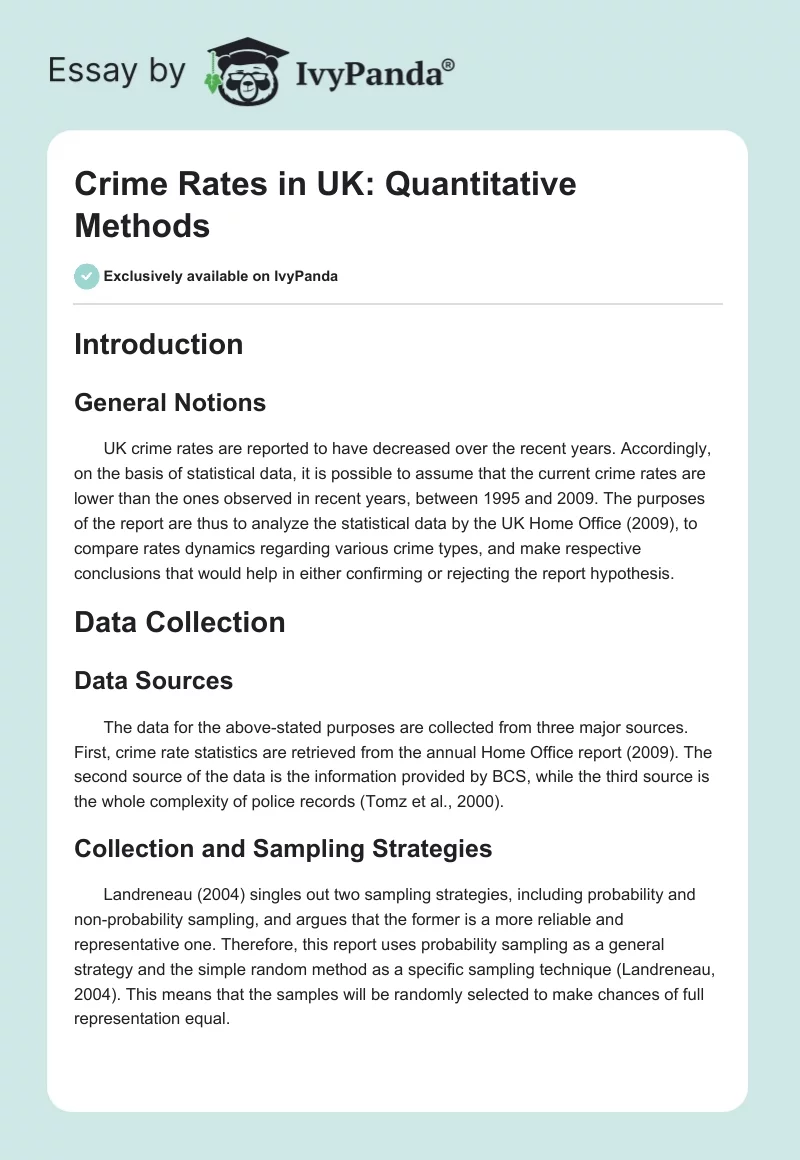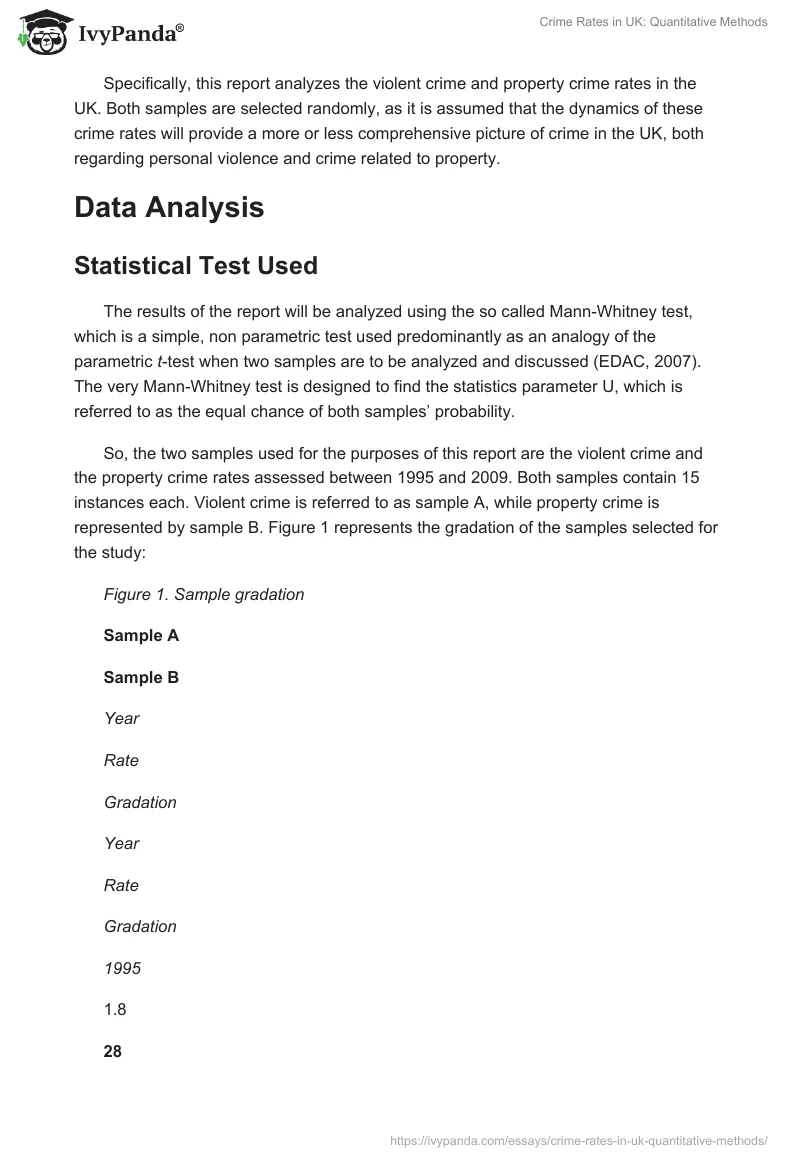Introduction
General Notions
UK crime rates are reported to have decreased over the recent years. Accordingly, on the basis of statistical data, it is possible to assume that the current crime rates are lower than the ones observed in recent years, between 1995 and 2009. The purposes of the report are thus to analyze the statistical data by the UK Home Office (2009), to compare rates dynamics regarding various crime types, and make respective conclusions that would help in either confirming or rejecting the report hypothesis.
Data Collection
Data Sources
The data for the above-stated purposes are collected from three major sources. First, crime rate statistics are retrieved from the annual Home Office report (2009). The second source of the data is the information provided by BCS, while the third source is the whole complexity of police records (Tomz et al., 2000).
Collection and Sampling Strategies
Landreneau (2004) singles out two sampling strategies, including probability and non-probability sampling, and argues that the former is a more reliable and representative one. Therefore, this report uses probability sampling as a general strategy and the simple random method as a specific sampling technique (Landreneau, 2004). This means that the samples will be randomly selected to make chances of full representation equal.
Specifically, this report analyzes the violent crime and property crime rates in the UK. Both samples are selected randomly, as it is assumed that the dynamics of these crime rates will provide a more or less comprehensive picture of crime in the UK, both regarding personal violence and crime related to property.
Data Analysis
Statistical Test Used
The results of the report will be analyzed using the so called Mann-Whitney test, which is a simple, non parametric test used predominantly as an analogy of the parametric t-test when two samples are to be analyzed and discussed (EDAC, 2007). The very Mann-Whitney test is designed to find the statistics parameter U, which is referred to as the equal chance of both samples’ probability.
So, the two samples used for the purposes of this report are the violent crime and the property crime rates assessed between 1995 and 2009. Both samples contain 15 instances each. Violent crime is referred to as sample A, while property crime is represented by sample B. Figure 1 represents the gradation of the samples selected for the study:
Figure 1. Sample gradation
The meaning of T, the sum of the sample A gradation meanings, is thus calculated as follows:
- T = 1 + 5 + 6 + 9 + 11 + 12 + 16 + 17 + 18 + 20 + 21 + 23 + 25 + 27 + 28 = 239
So, when T is calculated, it is possible to calculate U. For this, it is necessary to use the formula, in which NA and NB represent the numbers of instances in each sample:
- U = NA NB + NA(NA + 1) / 2 – T
- U = (15 x 15) + 15(15 + 1) / 2 – 239
- U = 225 + 240 / 2 – 239
- U = 225 + 120 – 239
- U = 106
Respectively, U’ can be found by extracting the meaning of U from the values of NA and NB multiplied. U’ in this case will reflect the probability of failure of the null hypothesis, according to which crime rates in UK have decreased over the recent years, between 1995 and 2009:
- U’ = NA NB – U
- U’ = 225 – 239
- U’ = – 14.
Test Results
So, the results of the Mann-Whitney test show that the crime rates in UK decreases between 1995 and 2009, and there is almost no probability of this hypothesis’ failure. The number of samples used is 2, with each one including 15 instances reflecting crime rate changes for 15 years. The significance of the test results is obvious as the results allow seeing the actual picture of crime rates in UK. The effect size is also considerable as crime rate reduction evidences the improvement of living standards and security prospects in UK. Finally, the statistical power of these results is so great as to encompass and reflect on the dynamics of UK crime rates over 15 years.
Discussion
The above presented analysis of statistical data using the Mann-Whitney test reveals the fact that the hypothesis, according to which UK crime rates have decreased between 1995 and 2009, is true. Such an idea is obtained from the fact that the Mann-Whitney test results provide no probability of the hypothesis failure for the analyzed data.
Further on, the results of the statistical analysis reported in this paper partly conform to the generally known and published statistics by the UK Home Office and the British Crime Survey. These results conform only partly, because the very Home Office report contains two seemingly opposite viewpoints. First, according to the BCS, crime rates remain stable in UK compared to the rates of early 2000s, while police records claim the crime rates to drop over this period for about 5 – 6% (Home Office, 2009).
As the results of the statistical analysis show, based on the data provided by the Home Office report (2009), both violent crime and property crime rates have decreased for approximately 50% between 1995 and 2009. Accordingly, one can assume that the police records are more adequate in their assessment of 5 – 6% reduction in crime over the last 3 years.
Conclusions
Accordingly, the logical conclusion of this report is that the crime rates in UK have been on the steady decrease since 1995, and the use of the Mann-Whitney test allowed proving this point not only by applying direct statistical data, but also by using those data to calculate the probabilities of confirming and rejecting the crime rate reduction hypothesis. So, it is recommended that statistical tests on the whole, and such non-parametric tests as the Mann-Whitney test in particular, should be used to trace the crime rate dynamics in UK as well as in other countries.
Works Cited
EDAC. Parametric and Non-Parametric Tests. Blackwell, 2007. Web.
Home Office. Crime in England and Wales 2008/2009. Home Office Statistical Bulletin, 2009. Web.
Landreneau, K. Sampling Strategies. NATCO, 2004. Web.
Tomz, M. et al. Interpreting and Presenting Statistical Results.Harvard University, 2000. Web.


